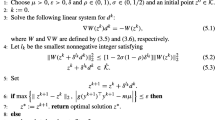Abstract
In this paper, the identification of immersed obstacles in a steady incompressible Navier–Stokes viscous fluid flow from fluid traction measurements is investigated. The solution of the direct problem is computed using the finite element method (FEM) implemented in the Freefem++ commercial software package. The solution of the inverse geometric obstacle problem (parameterized by a small set of unknown constants) is accomplished iteratively by minimizing the nonlinear least-squares functional using an adaptive moment estimation algorithm. The numerical results for the identification of an obstacle in a viscous fluid flowing in a channel with open ends, show that when the fluid traction is measured on the top, bottom and inlet boundaries, then the algorithm provides accurate and robust reconstructions of an obstacle parameterized by a small number of parameters in a Fourier trigonometric finite expansion. Stable reconstructions with respect to noise in the measured fluid traction data are also achieved, although for complicated shapes parameterized by larger degrees of freedom Tikhonov regularization of the least-squares functional may need to be employed. Multiple-component obstacles may also be identified provided that a good initial guess is provided. In case of limited data being available only at the inlet boundary the pressure gradient provides more information for inversion than the fluid traction.










Similar content being viewed by others
References
Conca C, Cumsille P, Ortega J, Rosier L (2008) On the detection of a moving obstacle in an ideal fluid by a boundary measurement. Inverse Probl 24:045001
Martins NFM, Silvestre AL (2008) An iterative MFS approach for the detection of immersed obstacles. Eng Anal Bound Elem 32:517–524
Badra M, Caubet F, Dambrine M (2011) Detecting an obstacle immersed in a fluid by shape optimization methods. Math Models Methods Appl Sci 21(10):2069–2101
Alvarez C, Conca C, Lecaros R, Ortega JH (2008) On the identification of a rigid body immersed in a fluid: a numerical approach. Eng Anal Bound Elem 32:919–925
Kress R, Meyer S (2005) An inverse boundary value problem for the Oseen equation. Math Methods Appl Sci 23:103–120
Karageorghis A, Lesnic D (2020) Identification of obstacles immersed in a stationary Oseen fluid via boundary measurements. Inverse Probl Sci Eng 28(7):950–967
Karageorghis A, Lesnic D, Marin L (2021) The method of fundamental solutions for Brinkman flows. Part I. Exterior domains. J Eng Math 126:10
Karageorghis A, Lesnic D, Marin L (2021) The method of fundamental solutions for Brinkman flows. Part II. Interior domains. J Eng Math 127:19
Alvarez C, Conca C, Friz L, Kavian O, Ortega JH (2005) Detecting an obstacle immersed obstacles via boundary measurements. Inverse Probl 21:1531–1552
Doubova A, Fernandez-Cara E, Ortega JH (2007) On the identification of a single body immersed in a Navier–Stokes fluid. Eur J Appl Math 18(1):57–80
Temam R (1977) Navier–Stokes equations: theory and numerical analysis. AMS Publishing, New York
Kingma DP, Ba J (2015) Adam: a method for stochastic optimization. In: International Conference on Learning Representations (ICLR2015), 15 p
Dapogny C, Frey P, Omnes F, Privat Y (2018) Geometrical shape optimization in fluid mechanics using FreeFem++. Struct Multidiscip Optim 58:2761–2788
Munson BR, Rothmayer AP, Okiiski TH (2013) Fundamentals of fluid mechanics. Wiley, New York
Layton W (2008) Introduction to the numerical analysis of incompressible viscous flows. Society for Industrial and Applied Mathematics, Philadelphia
Braack M, Mucha PB (2011) Directional do-nothing condition for the Navier–Stokes equations. J Comput Math 32(5):507–521
Glowinski R, Pironneau O (1992) Finite element methods for Navier–Stokes equations. Ann Rev Fluid Mech 24:167–204
Heywood JG, Rannacher R, Turek S (1996) Artificial boundaries and flux and pressure conditions for the incompressible Navier–Stokes equations. Int J Numer Methods Fluids 22:325–352
Hecht F (2012) New development in FreeFem++. J Numer Math 20(3–4):251–266
Schafer M, Turek S (1996) Benchmark computations of laminar flow around a cylinder. In: Hirschel EH (ed) Flow simulation with high-performance computers II. Springer, Berlin, pp 547–566
Powell WB (2019) A unified framework for stochastic optimization. Eur J Oper Res 275:795–821
Ozisik MN (2000) Inverse heat transfer. Routledge, New York
An LTH, Tao PD, Hao DN (2002) Towards Tikhonov regularization of non-linear ill-posed problems: a dc programming approach. Comptes rendus de l’Academie des Sciences de Paris Series I 335:1073–1078
Acknowledgements
This work was supported by The Scientific and Technological Research Council of Turkey (TUBITAK) [Grant Number: 1059B192000434]. No data are associated with this article. For the purpose of open access; the authors have applied a Creative Commons Attribution (CC BY) license to any Author Accepted Manuscript version arising from this submission.
Author information
Authors and Affiliations
Contributions
GY prepared figures and tables and typed the paper. GY programmed the FEM software. DL prepared the paper. GY and DL reviewed the manuscript.
Corresponding author
Ethics declarations
Conflict of interest
The authors declare no competing interests.
Additional information
Publisher's Note
Springer Nature remains neutral with regard to jurisdictional claims in published maps and institutional affiliations.
Rights and permissions
Springer Nature or its licensor (e.g. a society or other partner) holds exclusive rights to this article under a publishing agreement with the author(s) or other rightsholder(s); author self-archiving of the accepted manuscript version of this article is solely governed by the terms of such publishing agreement and applicable law.
About this article
Cite this article
Yuksel, G., Lesnic, D. The identification of obstacles immersed in a steady incompressible viscous fluid. J Eng Math 144, 16 (2024). https://doi.org/10.1007/s10665-023-10323-1
Received:
Accepted:
Published:
DOI: https://doi.org/10.1007/s10665-023-10323-1




